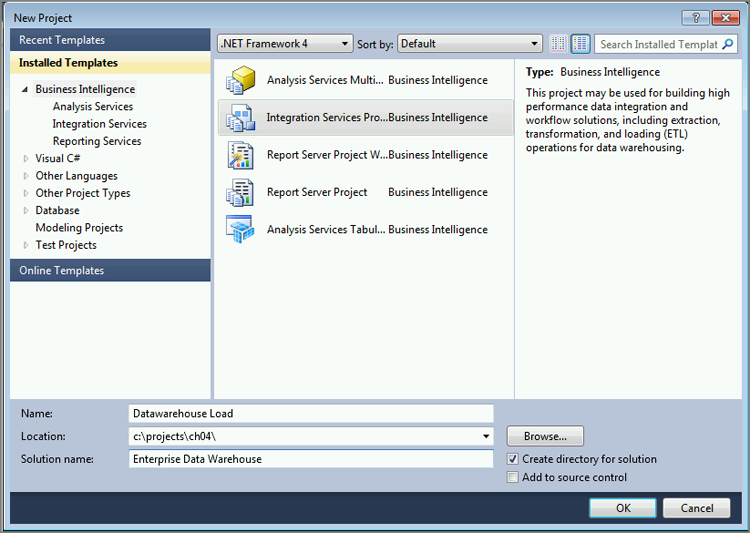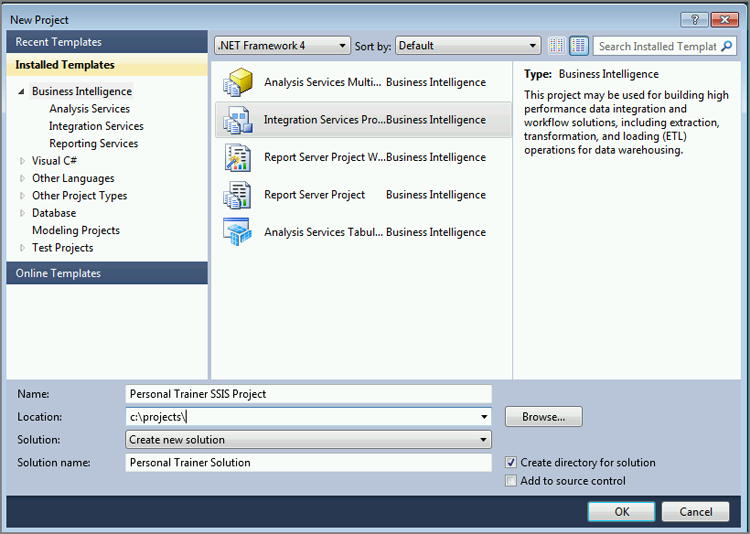Chapter 4
Creating a Solution and Project
You cannot create an SSIS package in SQL Server Data Tools (SSDT) without first having a solution and project. Additionally, for execution of the package in debug mode, which you use when troubleshooting, your package must be in a project and solution. Projects and solutions are containers for your packages that help you keep every component together and make you a more efficient SSIS developer.
SSDT is the program in which you’re going to develop your SSIS packages. In SQL Server 2012, SSDT is a Visual Studio 2010 shell. You can either open SSDT by itself under the SQL Server 2012 program group or open it by opening the full Visual Studio 2012 program.
An SSIS project is a container of one or more packages and other SSIS components. All the Visual Studio suite of products use the project construct to hold their files. For example, Reporting Services uses projects to hold its reports, and VB.NET uses projects to hold its VB.NET class files. In general, you want to align an SSIS project with a business project you’re working on. For example, you may have an SSIS project called “Data warehouse ETL.”
Projects mean much more in SQL Server 2012 than they did in SQL Server 2005 and 2008. This is because you now deploy projects, not packages, to production if your project is using the project deployment model. If you want to use the legacy deployment model where you deploy a package at a time, you will use the package deployment model. The new project deployment model is where many of the new SQL Server 2012 features that are discussed later in this book are used.
A solution is a container of one or more projects. Solutions enable many disparate types of projects to live under one container. For example, you may have a solution called “Enterprise Data Warehouse” with a SQL Server Reporting Services (SSRS) project called “Data warehouse reports,” another project for SSIS called “Data warehouse ETL,” and a final one for C# called “SharePoint code.” All of those projects could live under one roof, so if a report developer makes a change in his SSRS project, the SSIS developer is aware of that change.
When you create a project in SSDT, a solution is automatically created at the same time. To create a project, you can open SSDT and select File > New > Project. As you can see in Figure 4-1, the solution name is “Enterprise Data Warehouse” and its project is called “Datawarehouse Load.”
At first, the solution will not appear in your Solution Explorer because you have only a single project. Once you add a second project, it will appear. You can add subsequent projects into the same solution by going back to File > New > Project and selecting Add to Solution from the Solution drop-down box (which is shown in Figure 4-3 in the “Step-by-Step” later in this chapter). When you create your first project, you’ll notice in the Solution Explorer, which shows you all the projects and files, that there appears to be no solution. This is because solutions are hidden from you when you have only a single project in the solution. You can choose to always see the solution file in the Solution Explorer by going to Tools > Options and checking the Always show solution option in the Projects and Solutions page (shown in Figure 4-2).
Try It
In this Try It, you learn how to create your first solution and project, which you’ll be using throughout the rest of the book.
You can download examples of completed package, project, and solution files for this lesson from the book’s website at www.wrox.com.
Lesson Requirements
To successfully complete this lesson, you need to create a solution called Personal Trainer Solution and a project called Personal Trainer SSIS Project that will be used throughout this book.
Hints
- To create the project, open SQL Server Data Tools and select File > New > Project.



